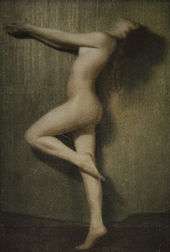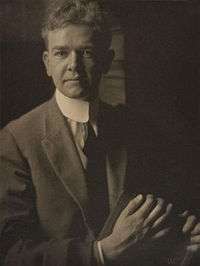Karl Struss
| Karl Struss | |
|---|---|
|
Photographer and cinematographer Karl Struss in 1912, photographed by Clarence H. White. | |
| Born |
November 30, 1886 New York, New York |
| Died |
December 15, 1981 (aged 95) Santa Monica, California |
| Education | Columbia University |
| Occupation | cinematographer |
| Title | A.S.C. |
| Awards |
Academy Award for Best Cinematography 1928 Sunrise: A Song of Two Humans (co-winner Charles Rosher) |

Karl Struss, A.S.C. (November 30, 1886 – December 15, 1981) was an American photographer and a cinematographer of the 1900s through the 1950s. He was also one of the earliest pioneers of 3-D films. While he mostly worked on films, such as F. W. Murnau's Sunrise: A Song of Two Humans and Charles Chaplin's The Great Dictator and Limelight, he was also one of the cinematographers for the television series Broken Arrow and photographed 19 episodes of My Friend Flicka.
Life and career
He was born in New York, New York, in 1886, and attended Columbia University,[1] graduating with a B.A. in 1912. He studied photography with Clarence H. White, a faculty member at Columbia. Initially, his reputation gained attention when twelve of his pictorial works were chosen for the Albright Art Gallery International Exhibition of Pictorial Photography by Alfred Stieglitz in 1910. This was the final exhibition of the Photo-Secession, an organization that promoted photography as fine art. .[2] As Struss continued his work and exhibitions, he produced commercial photography for magazines including Vogue, Vanity Fair, and Harper's Bazaar.[2] (However, he was quick to insist that he was not doing fashion photography.)
Struss invented the Struss Pictorial Lens, a soft-focus lens, in 1909. This lens was considered popular with pictorial photographers of the time. The Struss Pictorial lens was the first soft-focus lens introduced into the motion picture industry in 1916.[2] In 1919, he moved to Los Angeles and signed on with Cecil B. DeMille as a cameraman and subsequently worked on many films.[2] Struss was later admitted to the American Society of Cinematographers, and was a founding member of the Academy of Motion Picture Arts.[3] In 1949, he began his work in "stereo cinematography", becoming one of the first proponents of that art form. Unfortunately, he did most of his 3D work in Italy and none of his films were subsequently released in 3D in the United States.
Struss's photographic archive of exhibition prints, film stills, negatives and papers is available at the Amon Carter Museum of American Art located in Fort Worth, TX.[2]
Awards
In his career, Struss was nominated for an Academy Award for Best Cinematography four times. The first time, and the only time he won, was for F. W. Murnau's Sunrise: A Song of Two Humans in 1929, sharing that award with Charles Rosher. He was nominated again in 1932 for Dr. Jekyll and Mr. Hyde, in 1934 for The Sign of the Cross, and in 1942 for Aloma of the South Seas with Wilfred M. Cline, A.S.C. and William E. Snyder, A.S.C.
Selected filmography
- Ben-Hur (1925)
- Meet the Prince (1926)
- Sunrise: A Song of Two Humans (1927) with Janet Gaynor
- Babe Comes Home (1927) with Babe Ruth and Anna Q. Nilsson
- Night Watch (1928)
- Love and the Devil (1929)
- The Taming of the Shrew (1929) with Douglas Fairbanks and Mary Pickford
- Be Yourself! (1930) with Fanny Brice and Robert Armstrong
- Up Pops the Devil (1931) with Carole Lombard
- Dr. Jekyll and Mr. Hyde (1931) with Fredric March and Miriam Hopkins
- Island of Lost Souls (1932) with Charles Laughton and Bela Lugosi
- The Woman Accused (1933) with Nancy Carroll and Cary Grant
- Every Day's a Holiday (1937) with Mae West
- Double or Nothing (1937) with Bing Crosby, Andy Devine and William Frawley
- Some Like It Hot (1939) with Bob Hope, Shirley Ross and Gene Krupa
- Zenobia (1939) with Oliver Hardy and Harry Langdon
- The Great Dictator (1940) with Charles Chaplin and Paulette Goddard
- Journey Into Fear (1943) with Orson Welles and Joseph Cotten
- The Texan Meets Calamity Jane (1950) with Evelyn Ankers
- Lady Possessed (1952)
- Limelight (1952) with Charles Chaplin and Buster Keaton
- She Devil (1957) with Jack Kelly and Albert Dekker
- The Fly (1958) with Vincent Price
References
- ↑ Karl Struss biography, New York Times. By staff. Retrieved February 6, 2013.
- 1 2 3 4 5 McCandless, Barbara (1999). Struss, Karl Fischer. Cary, North Carolina: American National Biography. pp. 57–59.
- ↑ Brown, Turner and Elaine Partnow (1983). "Karl Struss". MacMillan Biographical Encyclopedia of Photographic Artists and Innovators. MacMillan Publishing Co.
External links
- Biography on 3D Gear website
- Karl Struss at the Internet Movie Database
- Karl Struss in 1912(portrait by Clarence H. White)
- Karl Struss 1912(by Clarence H. White, courtesy the Amer.Society of Cinematographers)
